TOYOTA C_HR HYBRID 2017 Owners Manual
Manufacturer: TOYOTA, Model Year: 2017, Model line: C_HR HYBRID, Model: TOYOTA C_HR HYBRID 2017Pages: 712, PDF Size: 49.31 MB
Page 351 of 712
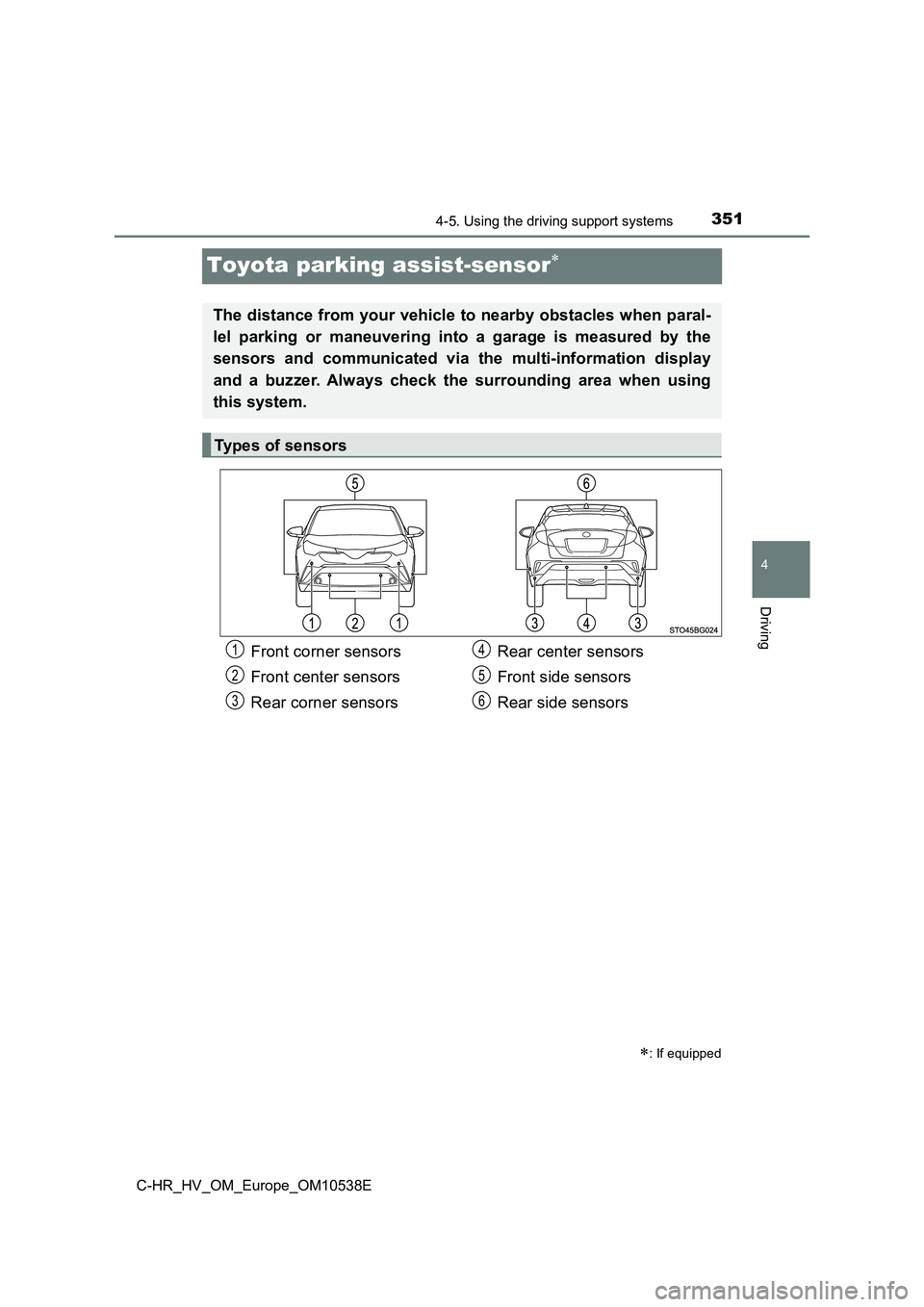
351
4
4-5. Using the driving support systems
Driving
C-HR_HV_OM_Europe_OM10538E
Toyota parking assist-sensor
: If equipped
The distance from your vehicle to nearby obstacles when paral-
lel parking or maneuvering into a garage is measured by the
sensors and communicated via the multi-information display
and a buzzer. Always check the surrounding area when using
this system.
Types of sensors
Front corner sensors
Front center sensors
Rear corner sensors
Rear center sensors
Front side sensors
Rear side sensors
1
2
3
4
5
6
Page 352 of 712
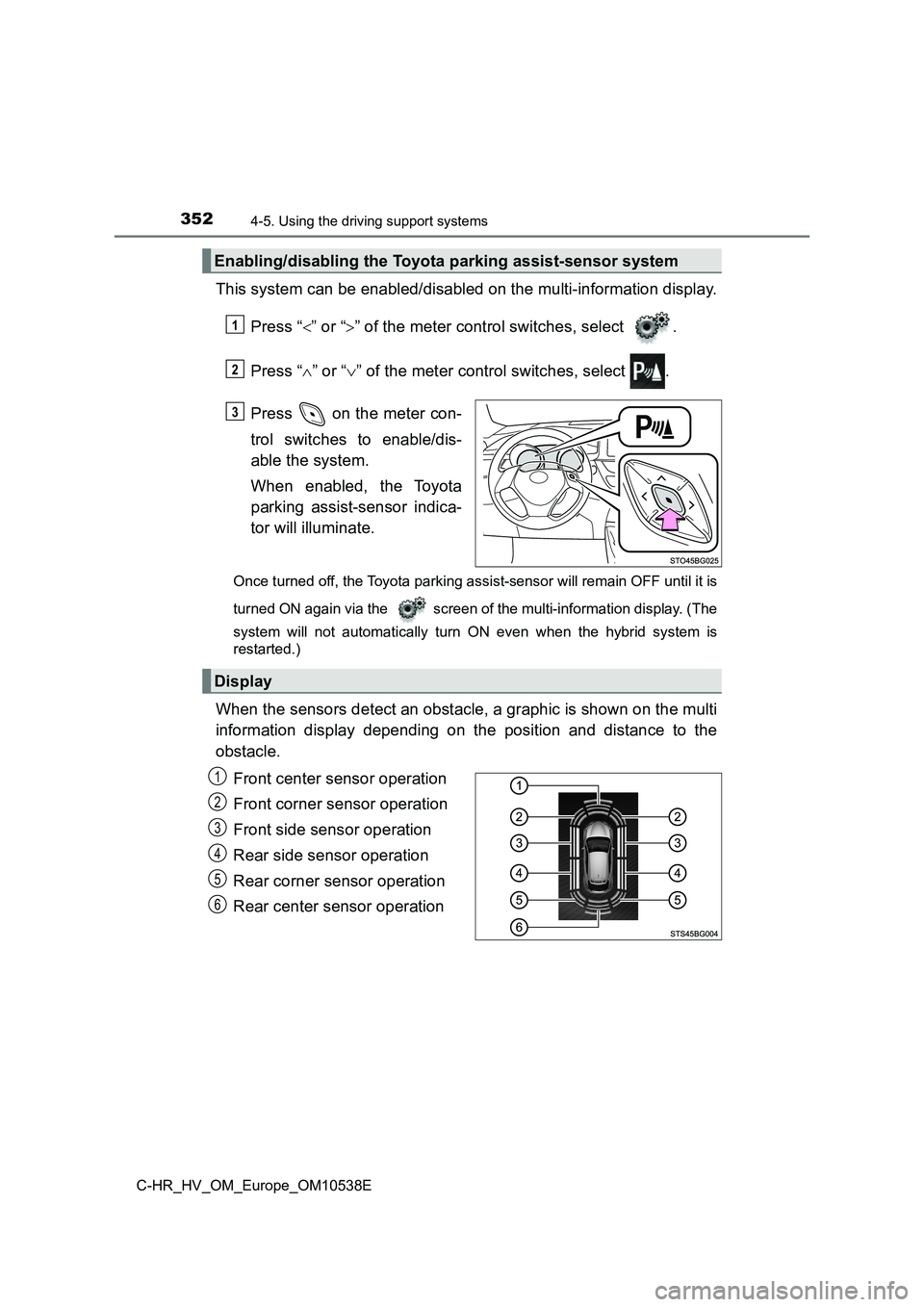
3524-5. Using the driving support systems
C-HR_HV_OM_Europe_OM10538E
This system can be enabled/disabled on the multi-information display.
Press “ ” or “” of the meter control switches, select .
Press “ ” or “” of the meter control switches, select .
Press on the meter con-
trol switches to enable/dis-
able the system.
When enabled, the Toyota
parking assist-sensor indica-
tor will illuminate.
Once turned off, the Toyota parking assist-sensor will remain OFF until it is
turned ON again via the screen of the multi-information display. (The
system will not automatically turn ON even when the hybrid system is
restarted.)
When the sensors detect an obstacle, a graphic is shown on the multi
information display depending on the position and distance to the
obstacle.
Front center sensor operation
Front corner sensor operation
Front side sensor operation
Rear side sensor operation
Rear corner sensor operation
Rear center sensor operation
Enabling/disabling the Toyota parking assist-sensor system
1
2
3
Display
1
2
3
4
5
6
Page 353 of 712
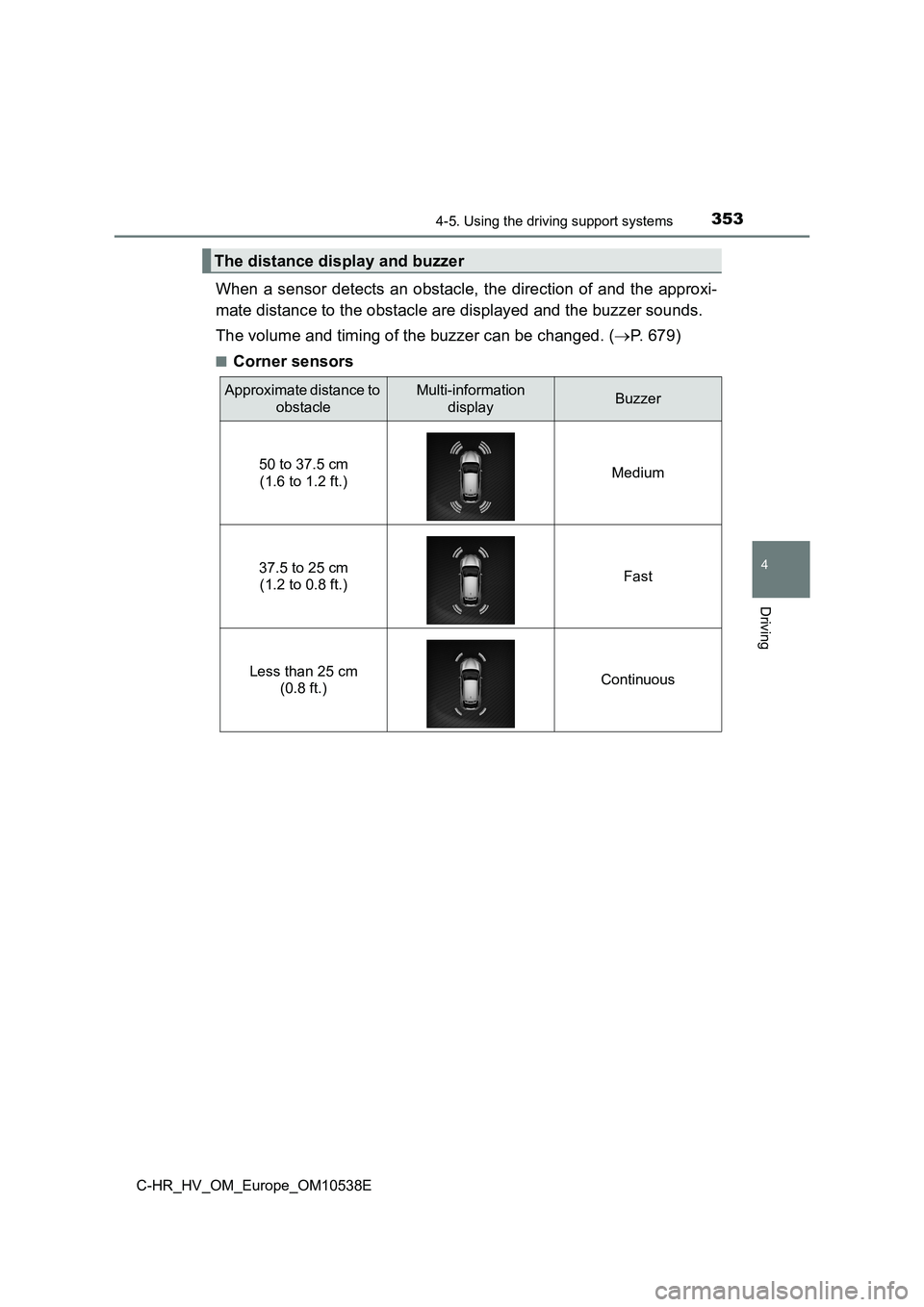
3534-5. Using the driving support systems
4
Driving
C-HR_HV_OM_Europe_OM10538E
When a sensor detects an obstacle, the direction of and the approxi-
mate distance to the obstacle are displayed and the buzzer sounds.
The volume and timing of the buzzer can be changed. ( P. 679)
■Corner sensors
The distance display and buzzer
Approximate distance to
obstacle
Multi-information
displayBuzzer
50 to 37.5 cm
(1.6 to 1.2 ft.) Medium
37.5 to 25 cm
(1.2 to 0.8 ft.) Fast
Less than 25 cm
(0.8 ft.) Continuous
Page 354 of 712
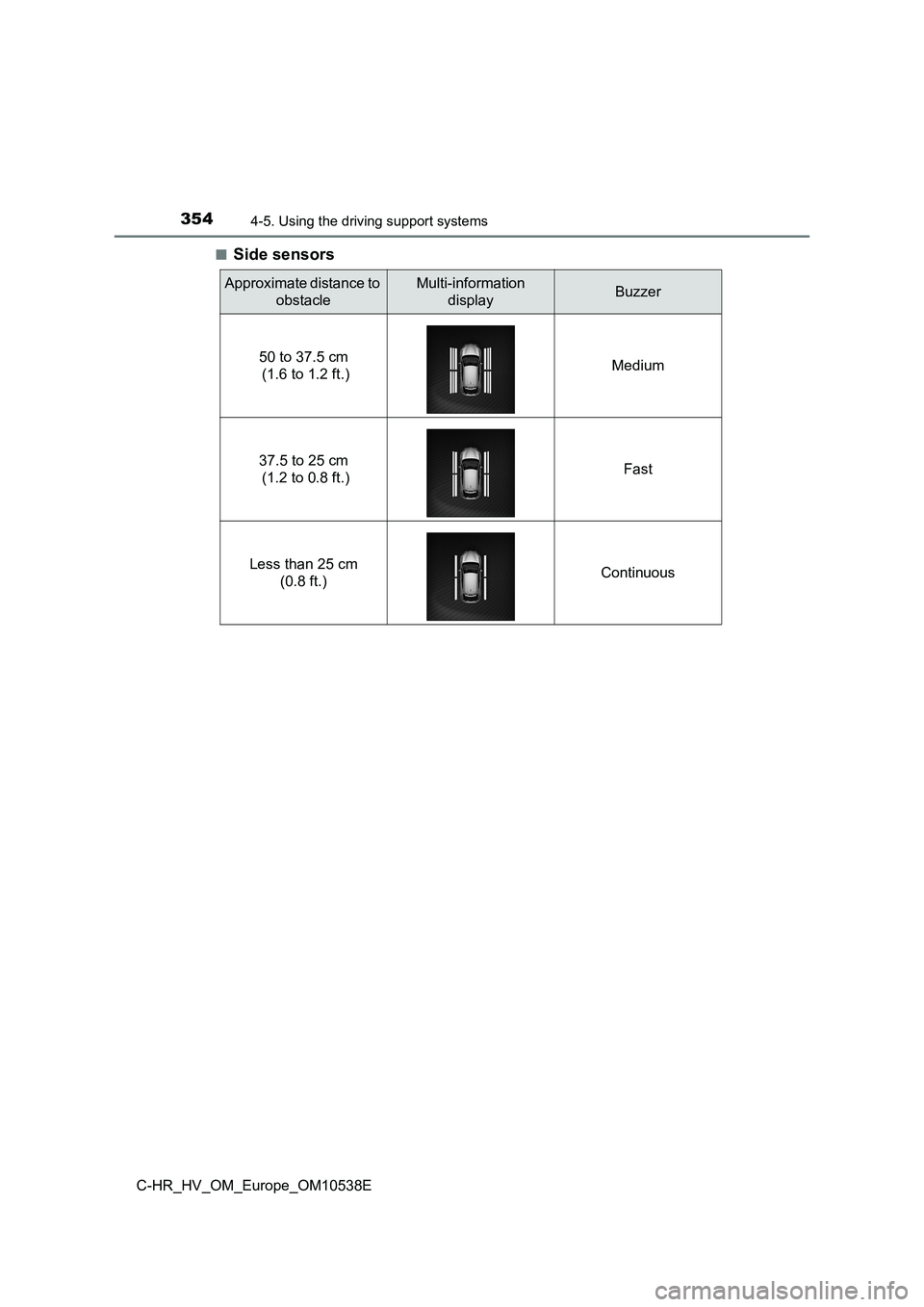
3544-5. Using the driving support systems
C-HR_HV_OM_Europe_OM10538E
■Side sensors
Approximate distance to
obstacle
Multi-information
displayBuzzer
50 to 37.5 cm
(1.6 to 1.2 ft.) Medium
37.5 to 25 cm
(1.2 to 0.8 ft.) Fast
Less than 25 cm
(0.8 ft.) Continuous
Page 355 of 712
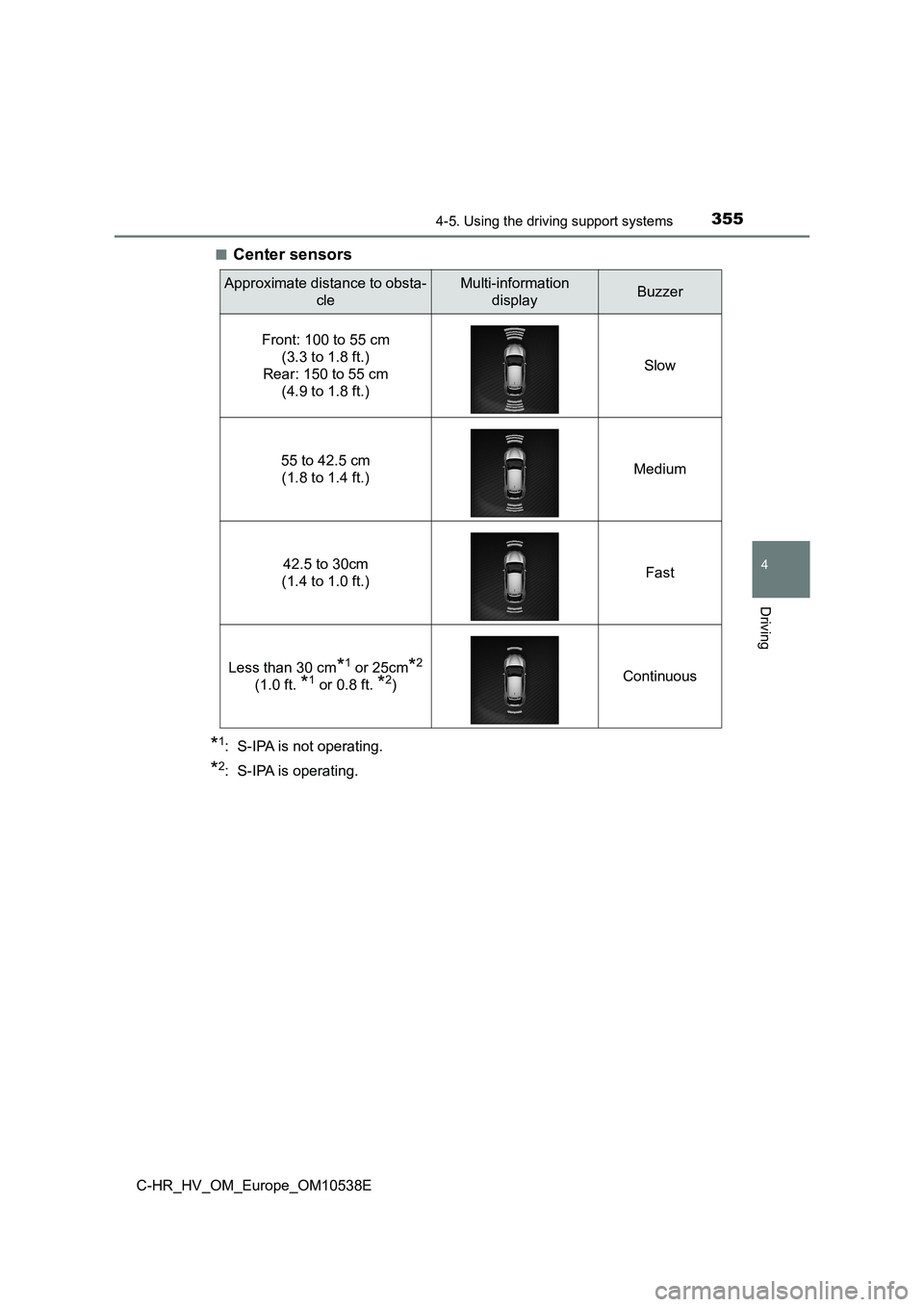
3554-5. Using the driving support systems
4
Driving
C-HR_HV_OM_Europe_OM10538E
■Center sensors
*1: S-IPA is not operating.
*2: S-IPA is operating.
Approximate distance to obsta-
cle
Multi-information
displayBuzzer
Front: 100 to 55 cm
(3.3 to 1.8 ft.)
Rear: 150 to 55 cm
(4.9 to 1.8 ft.)
Slow
55 to 42.5 cm
(1.8 to 1.4 ft.) Medium
42.5 to 30cm
(1.4 to 1.0 ft.) Fast
Less than 30 cm*1 or 25cm*2
(1.0 ft. *1 or 0.8 ft. *2) Continuous
Page 356 of 712
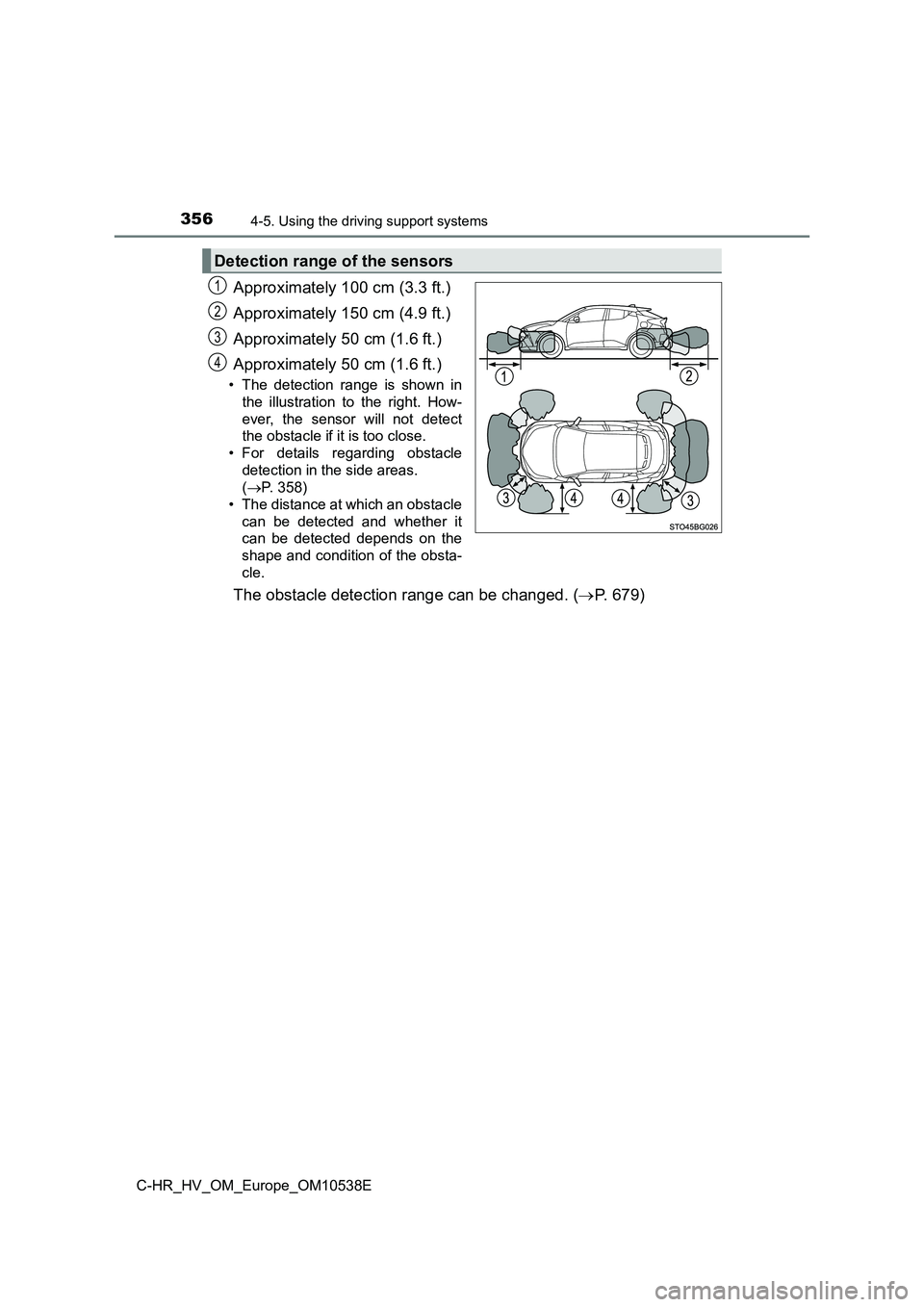
3564-5. Using the driving support systems
C-HR_HV_OM_Europe_OM10538E
Approximately 100 cm (3.3 ft.)
Approximately 150 cm (4.9 ft.)
Approximately 50 cm (1.6 ft.)
Approximately 50 cm (1.6 ft.)
• The detection range is shown in
the illustration to the right. How-
ever, the sensor will not detect
the obstacle if it is too close.
• For details regarding obstacle
detection in the side areas.
( P. 358)
• The distance at which an obstacle
can be detected and whether it
can be detected depends on the
shape and condition of the obsta-
cle.
The obstacle detection range can be changed. ( P. 679)
Detection range of the sensors
1
2
3
4
Page 357 of 712
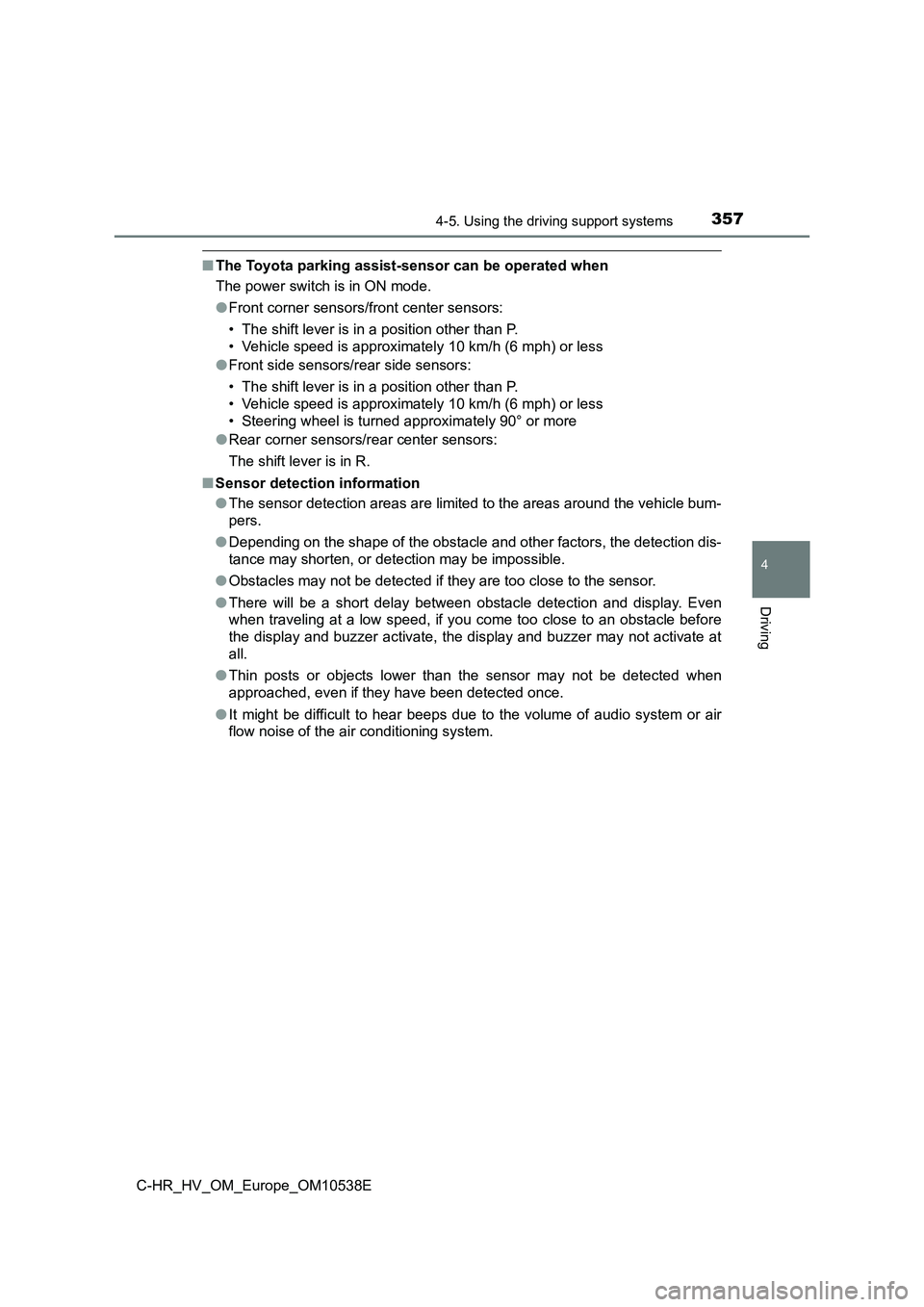
3574-5. Using the driving support systems
4
Driving
C-HR_HV_OM_Europe_OM10538E
■The Toyota parking assist-sensor can be operated when
The power switch is in ON mode.
● Front corner sensors/front center sensors:
• The shift lever is in a position other than P.
• Vehicle speed is approximately 10 km/h (6 mph) or less
● Front side sensors/rear side sensors:
• The shift lever is in a position other than P.
• Vehicle speed is approximately 10 km/h (6 mph) or less
• Steering wheel is turned approximately 90° or more
● Rear corner sensors/rear center sensors:
The shift lever is in R.
■ Sensor detection information
● The sensor detection areas are limited to the areas around the vehicle bum-
pers.
● Depending on the shape of the obstacle and other factors, the detection dis-
tance may shorten, or detection may be impossible.
● Obstacles may not be detected if they are too close to the sensor.
● There will be a short delay between obstacle detection and display. Even
when traveling at a low speed, if you come too close to an obstacle before
the display and buzzer activate, the display and buzzer may not activate at
all.
● Thin posts or objects lower than the sensor may not be detected when
approached, even if they have been detected once.
● It might be difficult to hear beeps due to the volume of audio system or air
flow noise of the air conditioning system.
Page 358 of 712
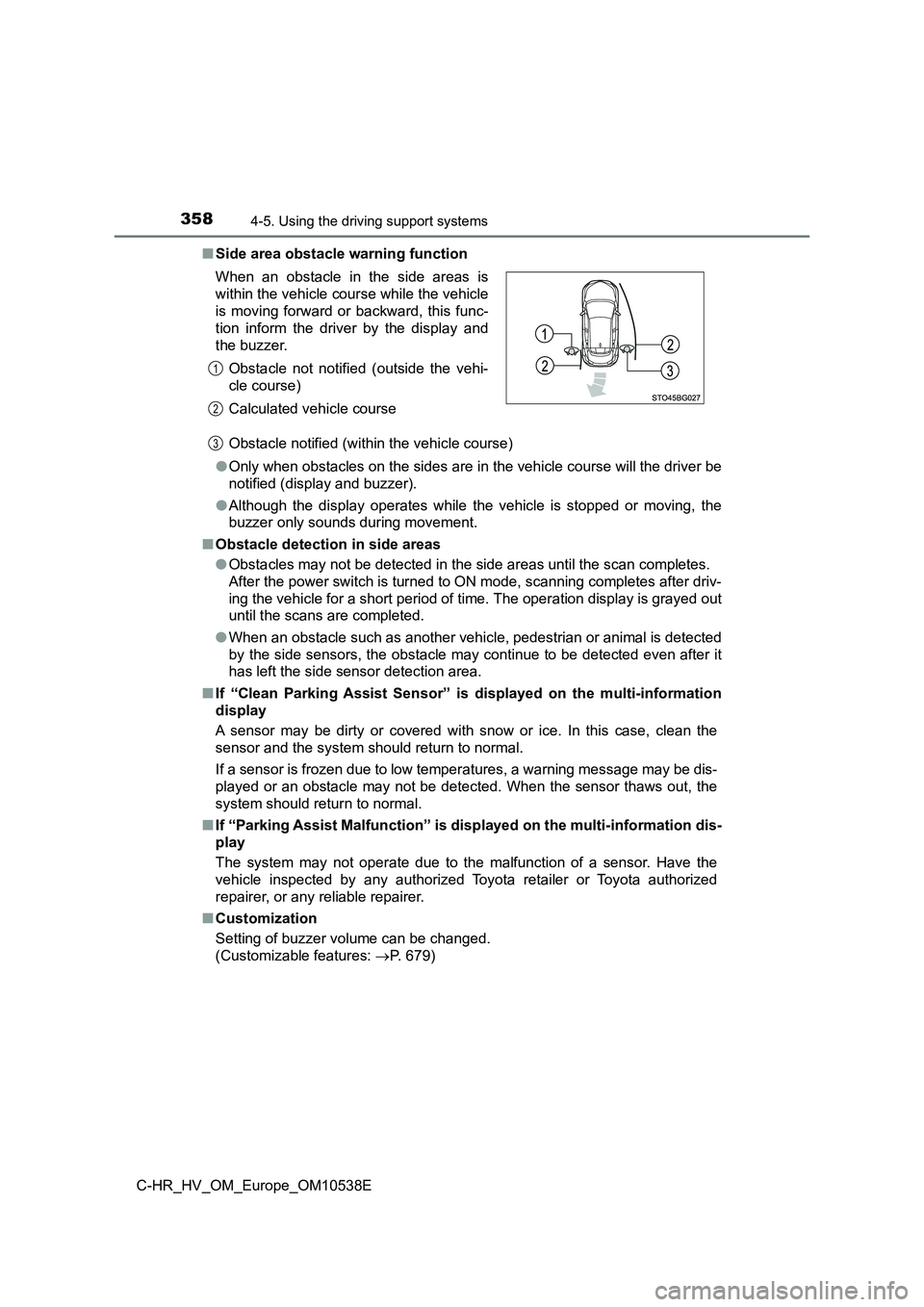
3584-5. Using the driving support systems
C-HR_HV_OM_Europe_OM10538E
■ Side area obstacle warning function
Obstacle notified (within the vehicle course)
● Only when obstacles on the sides are in the vehicle course will the driver be
notified (display and buzzer).
● Although the display operates while the vehicle is stopped or moving, the
buzzer only sounds during movement.
■ Obstacle detection in side areas
● Obstacles may not be detected in the side areas until the scan completes.
After the power switch is turned to ON mode, scanning completes after driv-
ing the vehicle for a short period of ti me. The operation display is grayed out
until the scans are completed.
● When an obstacle such as another vehicle, pedestrian or animal is detected
by the side sensors, the obstacle may continue to be detected even after it
has left the side sensor detection area.
■ If “Clean Parking Assist Sensor” is displayed on the multi-information
display
A sensor may be dirty or covered with snow or ice. In this case, clean the
sensor and the system should return to normal.
If a sensor is frozen due to low temperatures, a warning message may be dis-
played or an obstacle may not be detected. When the sensor thaws out, the
system should return to normal.
■ If “Parking Assist Malfunction” is displayed on the multi-information dis-
play
The system may not operate due to the malfunction of a sensor. Have the
vehicle inspected by any authorized Toyota retailer or Toyota authorized
repairer, or any reliable repairer.
■ Customization
Setting of buzzer volume can be changed.
(Customizable features: P. 679)
When an obstacle in the side areas is
within the vehicle course while the vehicle
is moving forward or backward, this func-
tion inform the driver by the display and
the buzzer.
Obstacle not notified (outside the vehi-
cle course)
Calculated vehicle course
1
2
3
Page 359 of 712
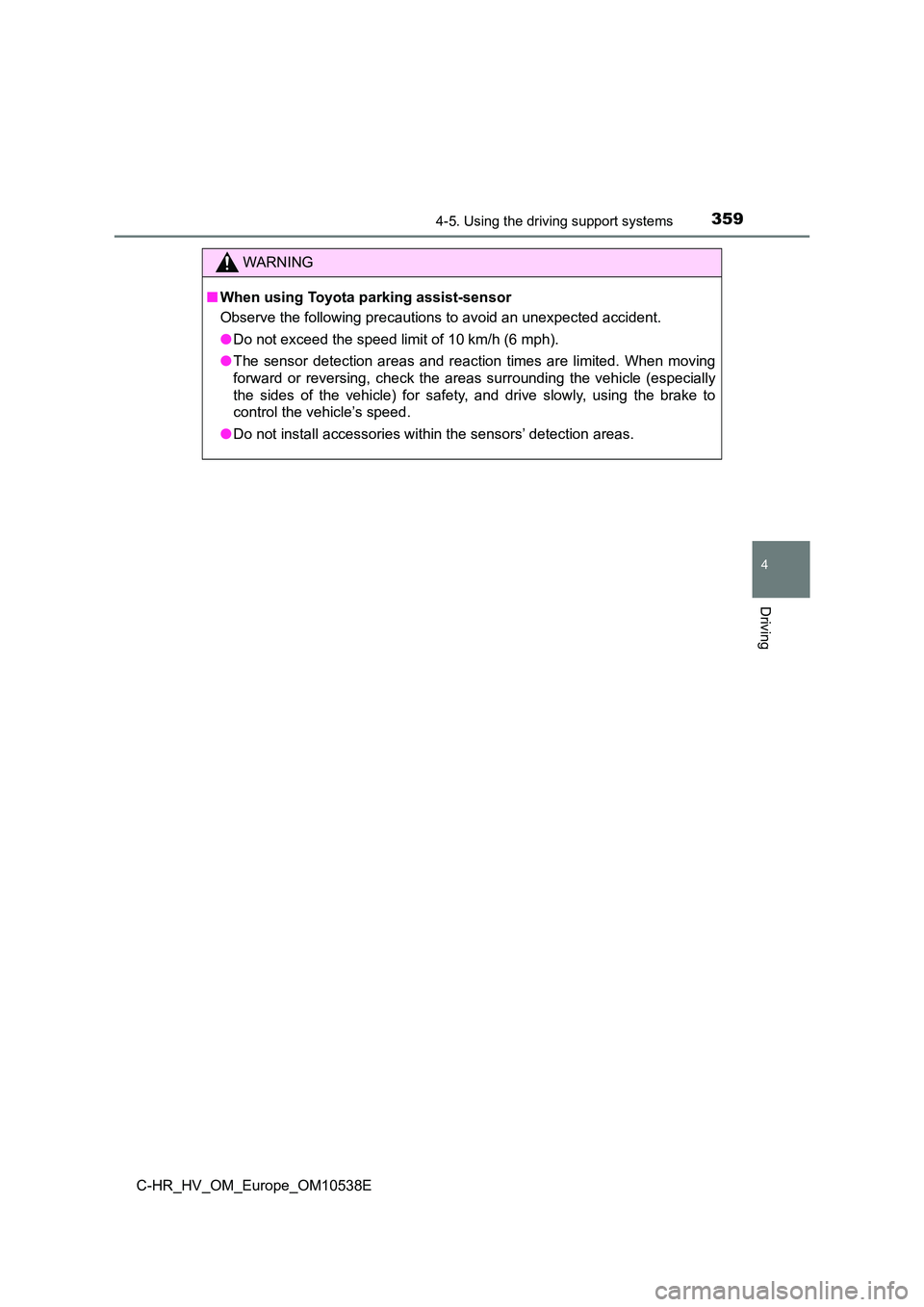
3594-5. Using the driving support systems
4
Driving
C-HR_HV_OM_Europe_OM10538E
WARNING
■When using Toyota parking assist-sensor
Observe the following precautions to avoid an unexpected accident.
● Do not exceed the speed limit of 10 km/h (6 mph).
● The sensor detection areas and reaction times are limited. When moving
forward or reversing, check the areas surrounding the vehicle (especially
the sides of the vehicle) for safety, and drive slowly, using the brake to
control the vehicle’s speed.
● Do not install accessories within the sensors’ detection areas.
Page 360 of 712
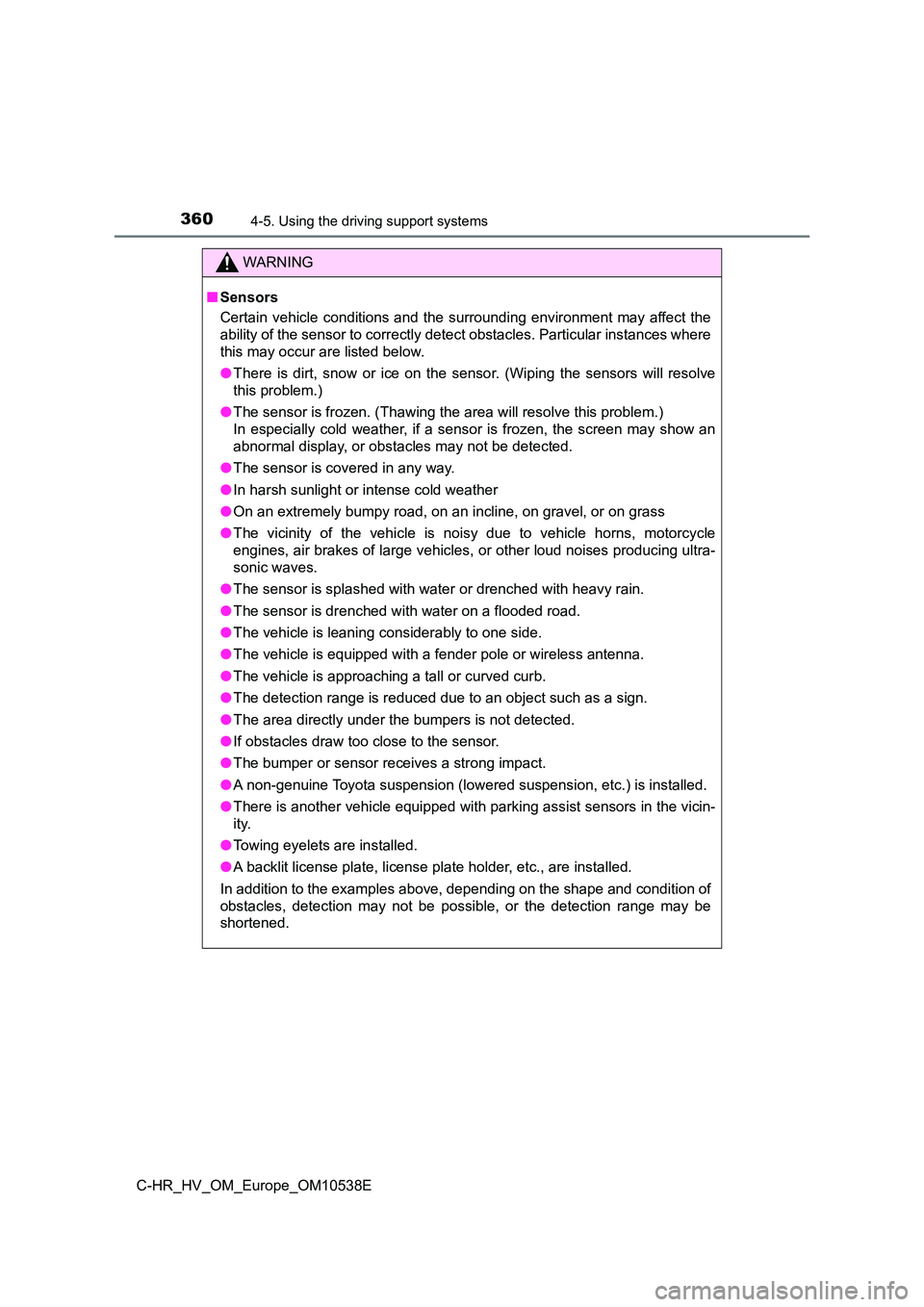
3604-5. Using the driving support systems
C-HR_HV_OM_Europe_OM10538E
WARNING
■Sensors
Certain vehicle conditions and the surrounding environment may affect the
ability of the sensor to correctly detect obstacles. Particular instances where
this may occur are listed below.
● There is dirt, snow or ice on the sensor. (Wiping the sensors will resolve
this problem.)
● The sensor is frozen. (Thawing the area will resolve this problem.)
In especially cold weather, if a sensor is frozen, the screen may show an
abnormal display, or obstacles may not be detected.
● The sensor is covered in any way.
● In harsh sunlight or intense cold weather
● On an extremely bumpy road, on an incline, on gravel, or on grass
● The vicinity of the vehicle is noisy due to vehicle horns, motorcycle
engines, air brakes of large vehicles , or other loud noises producing ultra-
sonic waves.
● The sensor is splashed with water or drenched with heavy rain.
● The sensor is drenched with water on a flooded road.
● The vehicle is leaning considerably to one side.
● The vehicle is equipped with a fender pole or wireless antenna.
● The vehicle is approaching a tall or curved curb.
● The detection range is reduced due to an object such as a sign.
● The area directly under the bumpers is not detected.
● If obstacles draw too close to the sensor.
● The bumper or sensor receives a strong impact.
● A non-genuine Toyota suspension (lowered suspension, etc.) is installed.
● There is another vehicle equipped with parking assist sensors in the vicin-
ity.
● Towing eyelets are installed.
● A backlit license plate, license plate holder, etc., are installed.
In addition to the examples above, depending on the shape and condition of
obstacles, detection may not be possible, or the detection range may be
shortened.